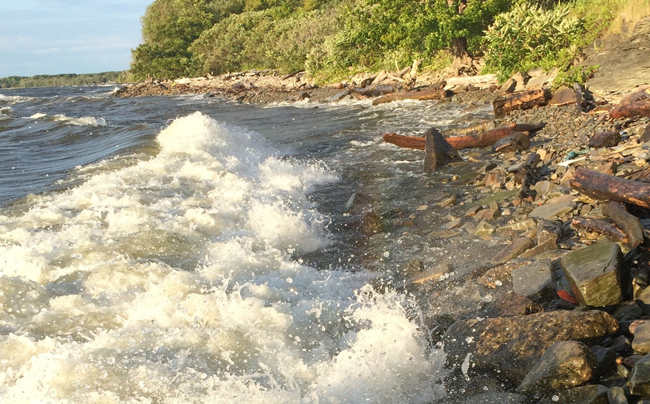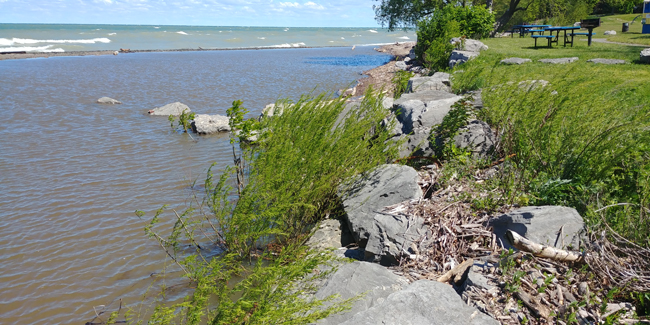Water, Wind, Waves: Western Lake Ontario, Lake Erie Erosion Virtual Assistance Workshops with New York Sea Grant on December 7th and 9th
New York Sea Grant Coastal Processes and Hazards Specialist Roy Widrig, author of Working with Nature, A Guide to Native Plants for New York’s Great Lakes Shorelines (pdf) (cover at left), will hold virtual workshops for Western Lake Ontario and Lake Erie shoreline owners respectively on December 7 and 9, 2021.
Contacts:
Roy Widrig, Great Lakes Coastal Processes and Hazards Specialist, E: rlw294@cornell.edu, P: (315) 312-3042
Kara Lynn Dunn, NYSG's Freelance Great Lakes Publicist, E: karalynn@gisco.net, P: (315) 465-7578
Oswego, New York, November 9, 2021 — Water, wind, waves, and time, even the gentle lapping of Lake Erie or Lake Ontario, erodes the Great Lakes shoreline. To mitigate the impact of shoreline erosion, New York Sea Grant (NYSG) Great Lakes Coastal Processes and Hazards Specialist Roy Widrig is inviting Lake Erie and Western Lake Ontario waterfront property owners to participate in online workshops on December 7 and December 9, 2021.

Waves breaking on Lake Ontario shoreline can cause erosive conditions that require mitigation. Credit: New York Sea Grant
The December 7, 2021 virtual workshop will be held from 1 pm to 4 pm with a specific focus on the Western Lake Ontario shoreline areas of Niagara and Orleans counties.

Cottonwood and willows help stabilize the shoreline along Lake Erie Beach in the Town of Evans, New York. Credit: Roy L. Widrig/New York Sea Grant
The action and impact of Lake Erie on properties in Erie and Chautauqua counties will be featured in the December 9, 2021 virtual workshop from 1 to 4 pm.
To register for either or both virtual workshops, see registration links in the "Related Links" box at the left hand side of this page or contact 315-312-3042 or SGOswego@cornell.edu for assistance.
“The processes of erosion and accretion along Lakes Erie and Ontario share some similarities, but vast differences in the physical makeup of their shorelines, and the differences in approaching management options must be considered when planning a project,” says Widrig, author of the Erosion Management for New York’s Great Lakes Shoreline Guide.
In each workshop Widrig will cover ways to address such issues as planning for lake level variations, designing and maintaining seawalls or rock rip-rap, water pooling in yards or basements, and general coastal processes. Participants will learn how they can freely access his expertise through New York Sea Grant’s “Virtual Shoreline Visit” tool.
Locally-based New York State Department of Environmental Conservation, New York State Department of State, and Army Corps of Engineers personnel will discuss the permitting process for shoreline projects and answer questions as part of each workshop.
Workshop participants will see before and after photos of properties that have applied options to achieve better drainage, bluff stabilization, and have used nature-based features or traditional structures to manage erosion. Widrig will also share tips as the author of “Working with Nature: A Guide to Native Plants for New York’s Great Lakes Shorelines.”
For more information on Great Lakes coastal processes and erosion, visit the website at www.nyseagrant.org/glcoastal.
More Info: New York Sea Grant
New York Sea Grant (NYSG), a cooperative program of Cornell University
and the State University of New York (SUNY), is one of 34 university-based
programs under the National Oceanic and Atmospheric Administration’s
National Sea Grant College Program.
Since 1971, NYSG has represented a statewide network of integrated
research, education and extension services promoting coastal community
economic vitality, environmental sustainability and citizen awareness
and understanding about the State’s marine and Great Lakes resources.
Through NYSG’s efforts, the combined talents of university scientists
and extension specialists help develop and transfer science-based
information to many coastal user groups—businesses and industries,
federal, state and local government decision-makers and agency managers,
educators, the media and the interested public.
The program maintains Great Lakes offices at Cornell University, University at Buffalo, SUNY Oswego and the Wayne County Cooperative Extension office in Newark. In the State's marine waters, NYSG has offices at Stony Brook University and Cornell Cooperative Extension of Nassau County on Long Island; at Brooklyn College, with New York City Department of Environmental Protection in Queens and at Cornell Cooperative Extension in NYC and Elmsford and Kingston in the Hudson Valley.
For updates on Sea Grant activities: www.nyseagrant.org has RSS, Facebook, Twitter, Instagram, and YouTube links. NYSG offers a free e-list sign up via www.nyseagrant.org/nycoastlines for its flagship publication, NY Coastlines/Currents, which is published quarterly.